Special Hobby 1/48 DFS 230A | 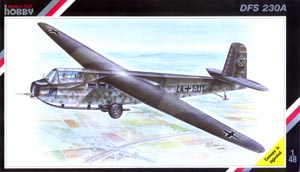 | History The Deustsches Forschungsinstitut für Segelflug, or German Research Institute for Gliding, was the organization that focused on the military use of gliders and also was responsible for the design of many assault gliders. Although the DFS 230 carries the DFS name, the organization only built the prototype, with the actual production taking place elsewhere. By 1938 the DFS 230 had reached operational units and by 1940 the usefulness of the type was proven. On May 10, 1940, the DFS 230 demonstrated its skills in silently deploying troops when several from LS-Kdo/Flieger Division 7 glided in on Belgian positions at Fort Eben Emael. Glider operations continued throughout the continental campaign and the DFS 230 found its way onto nearly every front. DFS 230 gliders were used in Mussolini’s rescue attempt and towards the end of the war, the glider was used with some success in resupply operations. The Kit 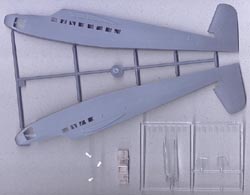 This latest release in Special Hobby’s 1/48 product line is an interesting one, and is probably the only injection molded DFS 230A we’ll see in this scale. The kit comes with four sprues of gray plastic, a handful of resin details, and a small photoetch fret, complete with instrument panel. A square decal sheet provides markings for a pair of gliders. The molding on both the plastic and the resin is crisp and the detailing is quite nice. The fabric effect on the wings is subdued and looks very realistic. There’s not much else to the outside of this kit, so let’s take a look at the inside. This latest release in Special Hobby’s 1/48 product line is an interesting one, and is probably the only injection molded DFS 230A we’ll see in this scale. The kit comes with four sprues of gray plastic, a handful of resin details, and a small photoetch fret, complete with instrument panel. A square decal sheet provides markings for a pair of gliders. The molding on both the plastic and the resin is crisp and the detailing is quite nice. The fabric effect on the wings is subdued and looks very realistic. There’s not much else to the outside of this kit, so let’s take a look at the inside.
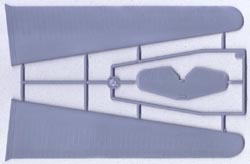 Since this is an assault glider, it comes with seats for 10: one pilot and nine soldiers. This is a skinny plane, though, so fitting those nine soldiers inside meant that they are all in a row, making for some rather cramped quarters. Since there are no figures in this kit, there is a bit more space to work with, luckily. The interior consists of a one-piece floor, with a resin cockpit seat and rudder pedals. Other than the photoetch seatbelts for the pilot’s seat, and the instrument panel, the rest of the interior is made up from plastic parts. The rear seats come in two pieces for the cushions, which rest atop some framework. The seatbacks are molded separately, and it is not too clear in the instructions just where all of these go. It almost appears that the back four seats face rearward, while the front five face forward. There are overhead straps above all the seats as well, what for I don’t know. Since this is an assault glider, it comes with seats for 10: one pilot and nine soldiers. This is a skinny plane, though, so fitting those nine soldiers inside meant that they are all in a row, making for some rather cramped quarters. Since there are no figures in this kit, there is a bit more space to work with, luckily. The interior consists of a one-piece floor, with a resin cockpit seat and rudder pedals. Other than the photoetch seatbelts for the pilot’s seat, and the instrument panel, the rest of the interior is made up from plastic parts. The rear seats come in two pieces for the cushions, which rest atop some framework. The seatbacks are molded separately, and it is not too clear in the instructions just where all of these go. It almost appears that the back four seats face rearward, while the front five face forward. There are overhead straps above all the seats as well, what for I don’t know.
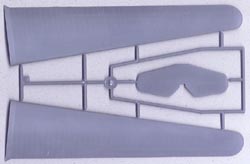 Once the interior is done, the rest of the model is simple. The wings are split top and bottom halves, and have a butt-joint to the fuselage. With wings this long a bit of a spar would have been nice, and probably would show on the inside of the fuselage of the real thing anyway. The horizontal stab is also split into upper and lower halves and fits into a notch at the base of the vertical fin on the fuselage. Some struts to brace the wings, a skid and wheel undercarriage, plus lots of windows for the fuselage, and the model is ready for painting. Once the interior is done, the rest of the model is simple. The wings are split top and bottom halves, and have a butt-joint to the fuselage. With wings this long a bit of a spar would have been nice, and probably would show on the inside of the fuselage of the real thing anyway. The horizontal stab is also split into upper and lower halves and fits into a notch at the base of the vertical fin on the fuselage. Some struts to brace the wings, a skid and wheel undercarriage, plus lots of windows for the fuselage, and the model is ready for painting.
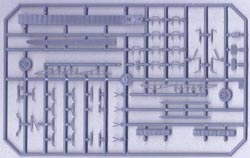 The options in the kit are very similar, differing only in the fuselage codes, really. Both are camouflaged in RLM 70/71 over RLM 65, with mottling on the fuselage sides. The instructions don’t state what units the two planes are from, but a quick check in Barry Rosch’s Luftwaffe Codes, Markings & Units 1939-1945 shows that the DFS 230A coded LA+1-111 was from I./LLG1. The second one, coded LH+1-8, is not known unit-wise, but in that same book there is a drawing of that glider, and Rosch lists it as a DFS 203B-1 at Comiso, Italy in 1942, with artwork on the nose resembling an elephant and a palm tree. I cannot say for certain who has the correct drawings for this plane, or even if there were two gliders coded the same. Either way, the decals themselves are well printed and aside from the multi-part swastikas should present no problems. The options in the kit are very similar, differing only in the fuselage codes, really. Both are camouflaged in RLM 70/71 over RLM 65, with mottling on the fuselage sides. The instructions don’t state what units the two planes are from, but a quick check in Barry Rosch’s Luftwaffe Codes, Markings & Units 1939-1945 shows that the DFS 230A coded LA+1-111 was from I./LLG1. The second one, coded LH+1-8, is not known unit-wise, but in that same book there is a drawing of that glider, and Rosch lists it as a DFS 203B-1 at Comiso, Italy in 1942, with artwork on the nose resembling an elephant and a palm tree. I cannot say for certain who has the correct drawings for this plane, or even if there were two gliders coded the same. Either way, the decals themselves are well printed and aside from the multi-part swastikas should present no problems.
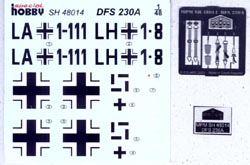 Conclusion Conclusion
This model opens up a whole pile of diorama possibilities. The DFS 230 was towed into the air by several different aircraft types, including Ju 52s, Ju 87s and Avia B. 534s. With decent kits of many towing aircraft available, I am sure it won’t be too long before we see a diorama of a DFS 230 being towed into the skies.
| 








|
